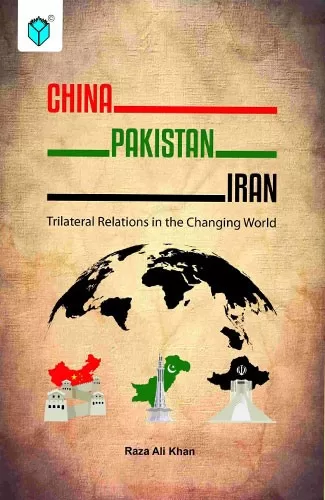Raza Ali Khan, Trilateral Relations in the Changing World
(Karachi: Paramount Books, 2023) ISBN: 978-627-310-024-1) (Pages: xxxiv, 330)
The trilateral relations between three Asian neighbours, China-Pakistan-Iran have always lacked scholarly attention. The leading academic circles of international intellectual communities generally emphasise upon the positions of these three states in their respective Asian sub-regions. The varying academic viewpoints on the bilateral interactions of Beijing, Islamabad, and Tehran with several other states have overwhelmed the existing literature concerning the changing power dynamics of broader Asian power politics.
In this way, the book under review presents a different image of emerging Asian power politics where the economic rise of China has become an undeniable reality and an irrefutable truth in the contemporary world, and Beijing’s multiplying trading connections with the outside world have started altering the conventional outlook of Asian regional politics. The central theme of the book talks about the Chinese government’s expanding cooperative economic ties with different states around the globe parallel to convincing several world leaders on the significance of economic developments in the contemporary international system. Akin to a few academic accounts addressing the changing dimensions of Asian power politics due to Beijing’s launched Belt and Road Initiative (BRI), the book under review is an academic endeavour to analyse the Chinese supported minilateral cooperative frameworks in its surrounding regions. The author of the book, Raza Ali Khan, is an emerging intellectual figure in the domestic policy circles of Islamabad due to having an exceptional combination of professional and academic capabilities. Besides serving in Pakistan’s Tehran-based diplomatic mission for several years, Khan has expressed his intellectual insights in Enigma of Suicide Terrorism: Separating Myth from the Reality (2010) and Leaving on the Edge – Pakistan-Iran Relations: Challenges and Prospects (2020). Both academic accounts of Khan are based on his non-traditional way of explaining several complexities regarding the issue of suicide terrorism and the complexities of cooperative bilateralism between Islamabad and Tehran. The third chapter of Khan’s book, China-Pakistan-Iran, continued his intellectual journey of focusing on an unexplored dimension of Asian power politics, where different states started building cooperative ties beyond conventional bilateral and multilateral frameworks. In this emerging wave of small alliances, China plays a central role in expanding its transnational economic connections worldwide.
The book’s seven chapters try to cover the trilateral interaction between three neighbouring states where the Chinese and Iranian governments have identified Pakistan as an essential component in constructing their bilateral economic collaboration. The book’s first chapter starts the debate from theoretical arguments and tries to strengthen the conceptual validity and intellectual legitimacy of the analysis compiled in the subsequent chapters. In the second chapter, the evaluation of post-pandemic (Covid-19) developments in world politics attempt to portray a brief picture of specific changes in the global power structure.
It outlines certain substantial changes in the international system affecting the conventional frameworks of strategic competitions between different states at the regional and global levels. The discussion diverted to a regional-level approach in the third chapter, where the author has attempted to concentrate on the complexities of foreign relations between India, Pakistan, and Iran. In this scenario, Chinese economic influences have proved to be the balancing forces, and the United States and Saudi Arabia have precisely emerged as important intervening factors in this situation, according to the book’s fourth chapter. The fifth chapter emphasised certain investigations highlighting the changing matrix of regional and global level politics in which the emerging US-China geostrategic competition has become a significant persuasive force globally. The last two chapters concluded the book by articulating a few remedies for the growing mistrust between the governments of three states Iran-Pakistan-China, before it becomes a compelling opportunity for the rival gathering of the anti-Chinese (or anti-BRI) nations.
The book’s central theme reflects the author’s extensive experience in diplomacy, and the analyses in all chapters are mainly supported by empirical data collected by the author from diverse sources. It ensures symmetry between primary and secondary data sources, which increases the legitimacy of the book’s arguments because the diplomatic experience of the author lets him explore the changing patterns of Asian regional politics deeply.
It has facilitated the author in understanding the emerging Asian economic alliances and the nature of prevailing strategic interests between key players of Asia. Moreover, the combination of economic and strategic cooperation of Asian states neighbouring Pakistan has remained the prime area of the author’s expertise, and he has tried to give it a fresh look about the China-Pakistan-Iran triangular interaction.
In other words, the central theme of the book exhibits the author’s in-depth analysis and ability to synthesise evolving cooperative ties between three territorially adjoining nations coherently. His academic background and professional diplomatic skills have made this book an exceptional account of various arguments describing a complex trilateral cooperation in the ongoing Asian power dynamics, which has regional and global implications.
Based on the abovementioned descriptions of the book, it is a valuable addition to the existing literature concerning the changing power attributes of the contemporary international system. The mainstream academic and policymaking circles concerning triangular relations between China, Pakistan, and Iran can find this book an interesting analysis account explaining the ongoing transformation of Asian power politics. The analysis maintained by the author in seven chapters presents a logically convincing and conceptually solid discussion concerning the change in Asian regional power dynamics, which has started departing from its traditional geostrategic domains.
The prevalence of geoeconomic thinking among key Asian players has convinced them to augment and diversify their trading collaboration with Beijing, where Pakistan and Iran emerged as essential actors. In this way, it is appropriate to maintain that this book can be treated as essential reading for policymakers, scholars, and anyone interested in understanding the future of regional and global power dynamics because the main framework of the book offers new perspectives on regional dynamics, global power shifts, and the emerging complexities of contemporary great power politics.





